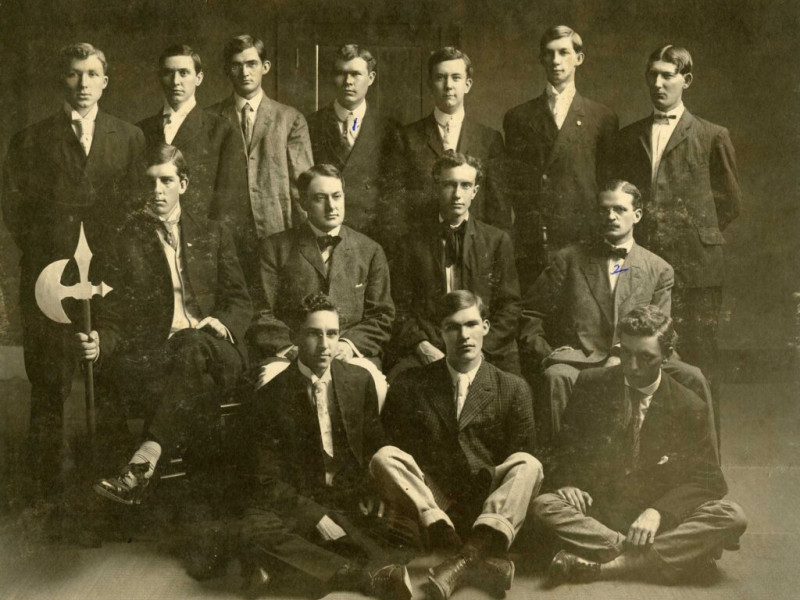





Written By Nik Koulogeorge

Written By
Published
Oct. 7, 2020
Updated
Feb. 7, 2023
Many fraternity traditions hang around like vestigial organs, shells of what they once were. While family trees and paddles have whittled down into meaningless trinkets you need to hide from a visiting consultant, composites remain as desirable and prominent as ever.
I was surprised as a member of my fraternity's office staff to learn that chapters without chapter houses still ordered physical composites. Some would store them at a member's house (student or alumnus). Others kept them in an office on campus or rented a storage room. That's kind of crazy because composite images cost a lot of money - like sometimes thousands of dollars.
Think about that. . . Ordering a framed composite is such an expected part of the fraternity experience that chapters without places to hang composites still order them and dream of the day when they can have a place to hang those (and future) composites.
No one really talks about the business of fraternity composites. It is not a personality-driven market like the speaker circuit. You pay for a product; you get the product; you sign a contract for more products. But those products are pricey. The idea of a chapter without a place to hang a framed composite signing a four-figure contract sounds absurd because it is absurd.
Thanks to advances in technology and tech literacy, chapters that are wary of the price tag have alternatives. This article includes tips to create your own composite and ideas to consider when planning your composite.
First, I want to share this Reddit post from /u/nerdpox.
Click the link above to read his full instructions and answers to questions and comments. He suggests a composite can be completed for as little as $250. My chapter recently put their composite together for about the same price. I'll share some points from his Reddit post below:
"If your chapter has the funds, I'll be honest, contract this out to a professional service. If not, read on"
"...if you have brothers in your chapter who have any design or photography experience, they should be involved or executing this. Starting from 1 percent is better than starting from zero."
Nerdpox doesn't dive into details, but reminds readers to find a way to organize attire, timing, and then offers three stages which separate "meh" composites from "good" composites:
Have a good setup for the photos. Consistency is key.
Find someone with a good camera (Defined as: a DSLR (a large "professional" style camera with a viewfinder) and a medium focal length lens (50mm-100mm) - anything lower than 50mm and you'll distort faces. Make your lights bright enough to be able to shoot at less than 1000 ISO.
Adds - If you do not have these kinds of things, you can use an iPhone X or XS or any recent smartphone that has a telephoto lens. When used in good lighting, the results will be great.
When it comes to using LED lights and setting the scene: "Do not mix LED with fluorescent in the room where you shoot - daylight is okay, even preferable. Find a neutral backdrop and have the subject several feet away so there aren't shadows, don't shoot somewhere with color on the walls since that will reflect onto the subject." (article about lighting setup)
"My approach was to cut each guy out in Photoshop and then put them on an artificial background in the actual composite" (a guide on YouTube)
"Do not design your composite in Photoshop;" use InDesign or similar publishing software
If you do not have someone skilled with design software then hire a student or freelancer. Send pictures of past composites to designers as a reference.
Paying for someone with design experience to handle this will still offer significant cost savings and will address one of the more complicated aspects of replicating a professional composite.
Find a local shop (if possible) with good reviews in your general area that has digital press capabilities and consult with them.
You'll want inkjet on semi-gloss or matte
Ask for samples with images of people on it, make sure it's not too flat looking or super glossy.
likely 24x36 or larger so this won't be super cheap but it should not be super expensive.
Ask the shop about what they need for color space (this is crucial) and what kind of settings they need you to set and what kind of file they're expecting for them to print with the best quality.
"Having a good partner in your printer is key because a good shop will evaluate your color settings before printing which can get complex. "
Remember, these could be your headshots: My chapter's tradition, in which the senior members of the chapter goof off in the composite photograph, is (way) off the rails. It can be hilarious, but modern composite photographs are ultimately meant to serve as headshots ... you know, the thing you put on LinkedIn, attach to resumés, or submit to publications. Combine your composite photography session with a career-development session. Get seniors and juniors, in particular, to think about headshots, internships, resumés, and job applications.
Opt for a group photo: That said, if your interest is in seeing everyone together, I humbly suggest a group photo. You can still take and offer headshots to members, but the group photos of yesteryear were (in my opinion) so much better than modern composites. Plus, secret society goofiness is way more fun with these types of pictures (like that well-shaven man with an ax).
Not everyone needs to MATCH-match. Although it's nice for everyone to look like they are of one tribe, everyone doesn't have to wear the same thing. Once again - please turn your attention to the old-school group photos. A little flexibility in the dress code can keep things interesting and may look a little less cheesy. Another idea may be to use color as an organizational tool. Perhaps your executive board members or graduating seniors wear a yellow blazer. Why yellow? I don't know, pick a different color!
Share your thoughts and ideas in the comments or (preferably) via Social Media.
Help keep it going and growing by contributing as little as $2. (Links below will take you to a secure payment portal via Stripe)
A free way to support: Subscribe to the Fraternity Man newsletter for [very occasional] updates and giveaways.